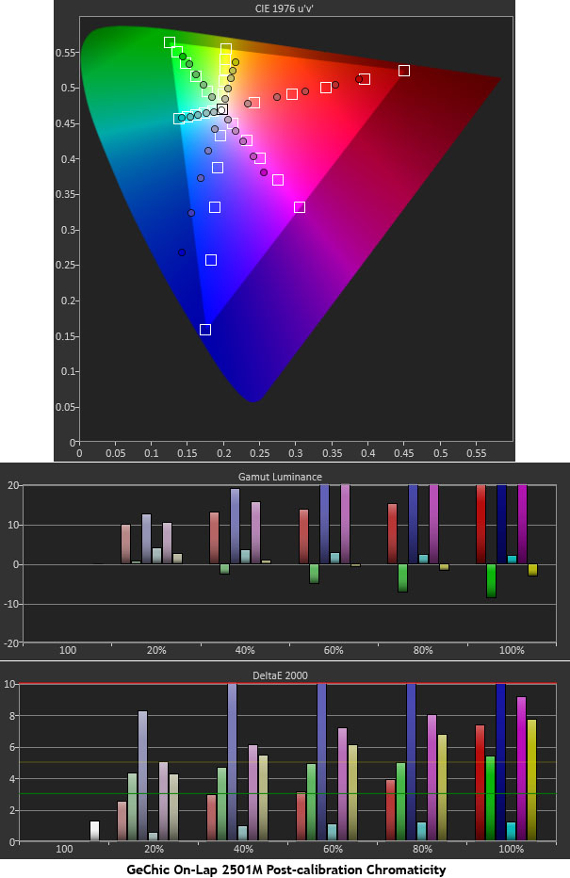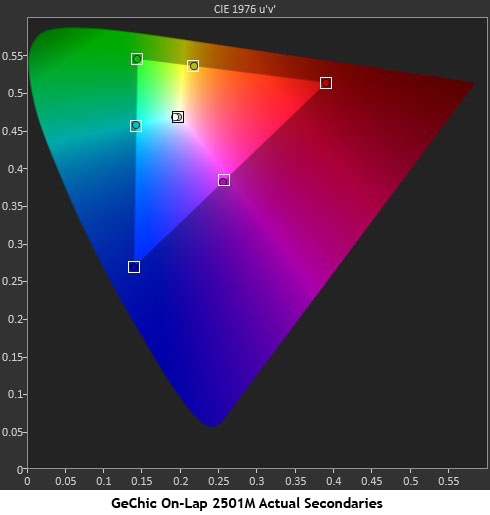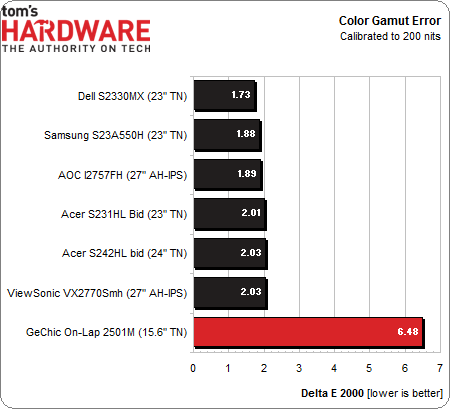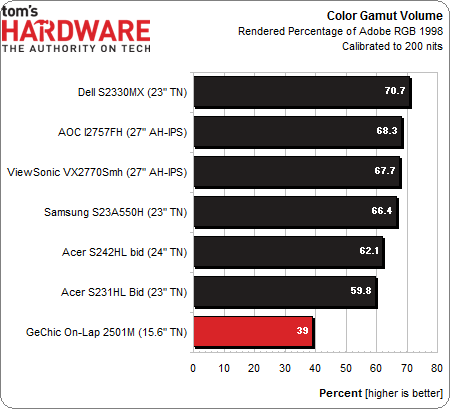GeChic On-Lap 2501M 15.6" Battery-Powered Monitor, Tested
Do you ever wish you could watch video on something larger than a smartphone when you're on the road? GeChic thinks it has an answer with the On-Lap 2501M portable monitor. We benchmark the display to see if its performance matches its convenience.
Results: Color Gamut And Performance
Color gamut is measured using a saturation sweep that samples the six main colors (red, green, blue, cyan, magenta, and yellow) at five saturation levels (20, 40, 60, 80, and 100%). This provides a more realistic view of color accuracy. The On-Lap has no color management system, so the chart is the same before and after calibration. Additionally, adjustments made to grayscale are too small to have any effect on the secondary color points.
This is the only area where we feel the On-Lap 2501M comes up short. Its color gamut is quite a bit smaller than the sRGB/Rec 709 standard.
Take a look at the dots furthest from the center of the CIE chart. They should be at or near the outermost squares, which represent the correct color points. It seems that only cyan is close to accurate. The other colors never quite reach the full saturation point. The visible effect is that the color looks somewhat washed out and light. This is made up for a little bit by the increased luminance, which you can see in the middle chart. Red, blue, and magenta are brighter than they should be, but this gives an illusion of extra saturation. And the Delta-E chart shows these errors are visible to the naked eye.
When a display measures this far off the standard, we do a test called Actual Secondaries. The monitor’s actual measured primaries are used to calculate where the secondary colors (cyan, magenta, and yellow) should be.
We can tell that the On-Lap is the product of some clever engineering because its secondaries fall exactly where they should in the altered gamut. Given this fact, combined with the increased luminance values, the color on this display actually looks OK. It’s a little washed-out, but not nearly as much as these charts suggest.
All of our recently-tested screens come much closer to the sRGB/Rec 709 standard.
The average value doesn’t tell the whole story of the On-Lap. The Delta-E error for blue is over 10, but the extremely low error for cyan pulls the average number down somewhat.
Get Tom's Hardware's best news and in-depth reviews, straight to your inbox.
Gamut Volume: Adobe RGB 1998
There are basically two categories of displays in use today: those that conform to the sRGB standard like HDTVs, and wide-gamut panels that show as much as 100 percent of the AdobeRGB 1998 spec. The On-Lap displays less than half the latter gamut. In fact, it only displays 55 percent of the sRGB gamut, which is a good deal behind other TN-based monitors.
We use Gamutvision to calculate the gamut volume, based on an ICC profile created from actual measurements. With only 39 percent of the AdobeRGB 1998 gamut available from the On-Lap, you won’t want to use this product for critical graphics work. Its color output would be difficult to match to other devices like cameras and printers. For gaming, video, and business use, though, it should be fine. Even though the color is under-saturated, the On-Lap is accurate relative to its actual color measurements.
Current page: Results: Color Gamut And Performance
Prev Page Results: Grayscale Tracking Next Page Results: Viewing Angle And Uniformity
Christian Eberle is a Contributing Editor for Tom's Hardware US. He's a veteran reviewer of A/V equipment, specializing in monitors. Christian began his obsession with tech when he built his first PC in 1991, a 286 running DOS 3.0 at a blazing 12MHz. In 2006, he undertook training from the Imaging Science Foundation in video calibration and testing and thus started a passion for precise imaging that persists to this day. He is also a professional musician with a degree from the New England Conservatory as a classical bassoonist which he used to good effect as a performer with the West Point Army Band from 1987 to 2013. He enjoys watching movies and listening to high-end audio in his custom-built home theater and can be seen riding trails near his home on a race-ready ICE VTX recumbent trike. Christian enjoys the endless summer in Florida where he lives with his wife and Chihuahua and plays with orchestras around the state.
-
mayankleoboy1 So even though the hardware itself is excellent, the final product is too niche-y to sell ?Reply -
slomo4sho A portable monitor at the conveniently low price of an entry level tablet or chromebook... I see real utility here.Reply -
warezme It is an industry artificial block in my opinion. All they would have to do is include a little extra circuitry to the existing pads for an HDMI input and viola, you could use your pad as a monitor to another device. Most pads have at least that resolution on some even better. I would never buy this item unless it was under $150 or less. It is a one trick pony with a low resolution screen.Reply -
groundhogdaze I'd love to have one of these portable monitors. I've go a bunch of headless PC's that I need to check every once in a while and don't want to lug a regular monitor around nor hunt for a power socket for the test monitor. If only the price were a little lower...Reply -
Fulgurant warezmeIt is an industry artificial block in my opinion. All they would have to do is include a little extra circuitry to the existing pads for an HDMI input and viola, you could use your pad as a monitor to another device. Most pads have at least that resolution on some even better. I would never buy this item unless it was under $150 or less. It is a one trick pony with a low resolution screen.I don't disagree that tablets could easily include an input, but to be fair, this product is far bigger than a tablet. It may only have a niche use, but it is clearly better suited for that niche use than a tablet screen would be.Reply -
Fulgurant FulgurantI don't disagree that tablets could easily include an input, but to be fair, this product is far bigger than a tablet. It may only have a niche use, but it is clearly better suited for that niche use than a tablet screen would be.Come to think of it, laptops should include inputs too -- but to my knowledge, they never have.Reply -
g00fysmiley interesting concept but would be nice if bluetooth connectivity wee there unless i am missing somethign it s hdmi only. touchscereen i know is pricier but again would add to utility. interesting product just as it is looks very limitedReply -
RedJaron Senor Kalyanhttp://us.aoc.com/monitor_displays/e2251fwuNice product, except it doesn't have its own power supply and can only take a USB signal over a DisplayLink driver. Makes for a nice quasi-mobile secondary monitor for computers, but it won't connect to most types of mobile devices like the GeChic will.Reply



